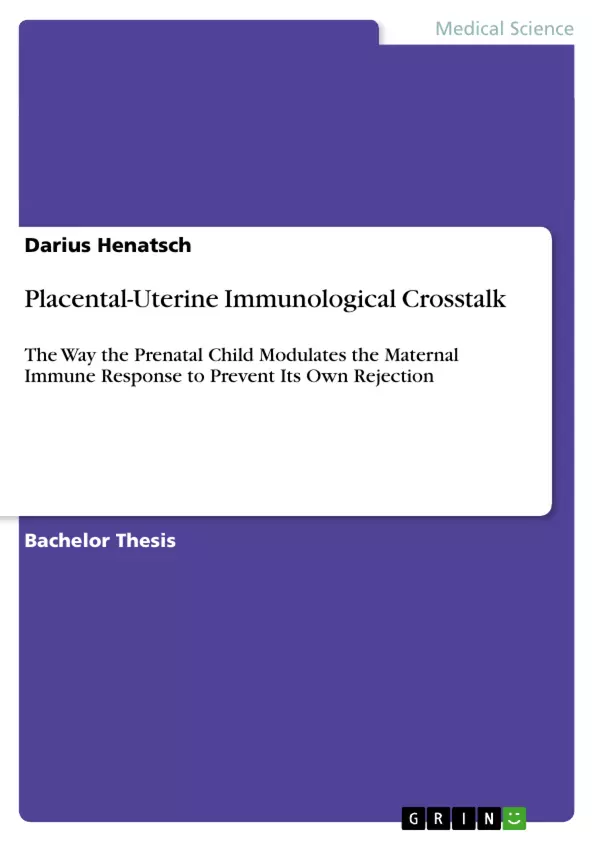The main issue of this paper is the question how the placenta, in particular placental trophoblast cells, prevent a maternal allograft immune rejection by modulating the immune response in the uterine side of implantation.The attempt is done to give insights about special immunological interactions at the placental-uterine side of implantation that makes the fascinating event of pregnancy possible. Of main interest are interactions between trophoblast human leukocyte antigens (HLAs), natural killer (NK) cells as well as T lymphocytes, in questions of state of the art literature. Although a broad introduction is given to the development of the embryo until nidation; how the uterus is made up during implantation and the mechanisms of placentation.
Inhaltsverzeichnis (Table of Contents)
- Introduction
- The Uterus
- Anatomy and Alteration in the Cycle
- Special Make-up during Embryonic Nidation
- The Placenta
- From Fertilization to Nidation
- Implantation and Placentation
- Function
- Nutrition
- The Placenta as a Hormonal Organ
- Barrier between Fetal and Maternal Circulation
- Immunological Uterine-Placental Crosstalk
- Immunologic Reaction to Foreign, Allogeneic Tissue
- Maternal Cells Involved in Direct Interactions
- NK Cell Receptor Interactions
- CD94/NKG2
- KIR (killer cell Ig-like receptor)
- ILT (Ig-like transcript)
- Major Histocompatibility Complex (MHC) Expression on Placental Cells
- Human Leukocyte Antigens (HLAs)
- Characteristics of Classical and Non-classical MHC Class I Molecules
- Subgroups of Trophoblast HLA Class I Antigens
- HLA-E
- HLA-C
- Special role of HLA-G
- Unique HLA-G Features
- HLA-G Interactions with Maternal Cells
- T Cell Interactions
- B Cell Interactions
- Monocyte Interactions
- Discussion and Conclusion
Zielsetzung und Themenschwerpunkte (Objectives and Key Themes)
This paper explores the fascinating interplay between the placenta and the maternal immune system during pregnancy. Its primary objective is to unravel the mechanisms by which the placenta, specifically placental trophoblast cells, evade immune rejection by the mother's body. Key themes explored in this paper include:- The unique immunological environment of the uterus during implantation
- The role of trophoblast cells in modulating the maternal immune response
- The interactions between HLA-G and various maternal immune cells, particularly NK cells and T lymphocytes
- The unique functions of the placenta, including its role as a hormonal organ and a barrier between fetal and maternal circulation
- The intricate adaptations of the placenta and uterus that facilitate successful implantation and pregnancy
Zusammenfassung der Kapitel (Chapter Summaries)
This section summarizes the main points of the paper, excluding any information from the Discussion and Conclusion sections.The Uterus
This chapter discusses the anatomy of the uterus and how it undergoes changes during the menstrual cycle. It highlights the importance of the endometrium, the outermost layer of the uterus, which undergoes a monthly cycle of growth and shedding. The chapter emphasizes the role of natural killer (NK) cells in the uterus and their critical involvement in creating a favorable environment for implantation.The Placenta
This chapter provides a comprehensive overview of the placenta, starting with its development from fertilization to implantation. It details the process of placentation, where the placenta becomes fully established and begins to function. The chapter then discusses the various functions of the placenta, including its role in providing nutrients to the developing fetus, acting as a hormonal organ, and serving as a barrier between the fetal and maternal circulatory systems.Immunological Uterine-Placental Crosstalk
This chapter delves into the complex interplay between the maternal immune system and the placenta. It examines the immune response to foreign, allogeneic tissue, with particular emphasis on the unique tolerance that the maternal immune system exhibits toward the placenta. This chapter also explores the specific maternal cells involved in direct interactions with the placenta, notably NK cells.Major Histocompatibility Complex (MHC) Expression on Placental Cells
This chapter focuses on the expression of human leukocyte antigens (HLAs) on placental cells. It delves into the characteristics of classical and non-classical MHC class I molecules and explores the unique subgroups of trophoblast HLA class I antigens, including HLA-E and HLA-C.Special role of HLA-G
This chapter highlights the unique features of HLA-G, a non-classical MHC class I molecule expressed by trophoblast cells. It explains how HLA-G interacts with various maternal cells, including T cells, B cells, and monocytes. The chapter explores the significant role of HLA-G in immune modulation during pregnancy.Schlüsselwörter (Keywords)
The main keywords and focus topics of this paper include:- Placental-uterine immunological crosstalk
- Trophoblast cells
- Immune modulation
- HLA-G
- Natural killer (NK) cells
- T lymphocytes
- Implantation
- Pregnancy
- Decidua
- Uterine environment
- Citar trabajo
- Darius Henatsch (Autor), 2007, Placental-Uterine Immunological Crosstalk, Múnich, GRIN Verlag, https://www.grin.com/document/134744



